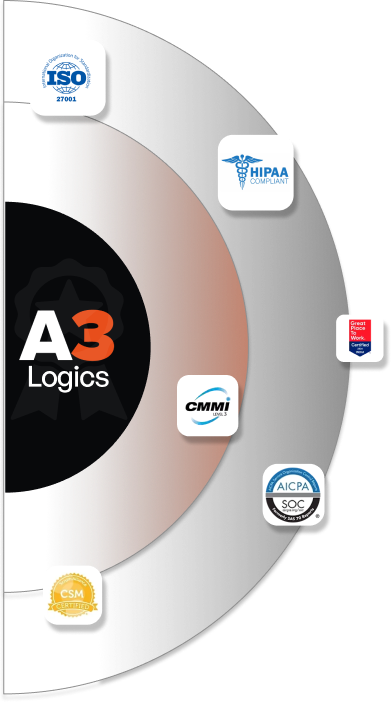The technologies and platforms underpinning a music streaming app development have a huge influence on its performance, capabilities, costs, and success. Selecting the appropriate combinations of programming languages, databases, frameworks, cloud platforms, media streaming solutions, and other developer tools for the specific needs of your music streaming app forms its tech stack. While there are many options to choose from, making the right choices based on factors like scalability, costs, developer experience, ease of upgrades and cross-platform capabilities is critical. This blog discusses the important considerations when selecting a tech stack for developing a high-quality music streaming application that can meet current and future demands.
Table of Contents
Overview of the music streaming app Market
The music market has grown rapidly in recent years driven by increasing smartphone and internet penetration with advancements from music streaming app development company. These apps offer vast libraries of songs that users can access on demand without having to own the music. They are transforming how people listen to and consume music.
Some key players in this market include Spotify, Apple Music, Amazon Music, YouTube Music, and Pandora. Spotify is currently the market leader with over 160 million active users as it offers both free ad-supported and premium subscription services. Apple Music has over 60 million subscribers who can access its massive library of over 50 million songs. Amazon Music and YouTube Music have large catalogs of music and are growing rapidly, leveraging their strong consumer bases. Pandora mainly offers a free radio service where users can create custom stations based on songs, artists, or genres.
The key to success in this market is acquiring music licenses from major record labels, building large music libraries, offering customized recommendations, providing offline listening, and creating a superior user experience. Revenue for a music streaming app development company comes from subscription fees, advertising, and commissions from song purchases. The future of the market looks promising with growing demand for on-demand music streaming and the entry of new players.
Importance of selecting the right tech stack for Music streaming app development
The tech stack used for music streaming app development plays a critical role in the success of the app. A well-chosen tech stack can help create an engaging user experience, optimize performance and costs, and future-proof the app.
Some important considerations when selecting a tech to create a music streaming app are:
- Scalability: It should be able to scale well to handle millions of users and terabytes of music data.
- Storage: Able to store large music libraries and high-resolution audio files efficiently.
- Streaming: Should support streaming of high-quality, low-latency music to users.
- Responsiveness: Technologies that optimize app loading times and response to user actions.
- Costs: The total cost of ownership including development, maintenance, and licenses.
- Security: A secure tech stack to protect users’ data and music intellectual property.
- Cross-platform: Ability to develop apps for both iOS and Android from the same codebase.
- Future updates: Technologies that are actively updated so the app can evolve.
Popular tech stacks for Music streaming apps include Java or Kotlin for Android, Swift or Objective C for iOS, a cloud platform like AWS or GCP, a NoSQL database like MongoDB, media streaming services, and a framework like React Native for cross-platform development. Consult the top mobile app development company to choose the best tech stack for your music streaming app.
Understanding the Key Components of a Music Streaming App
A modern music streaming app has several essential technical components that work together to deliver a seamless music experience to users. The core components are:
- Backend – The backend servers manage the app’s database, process user requests, and authenticate users. The backend is responsible for searching the music library, managing playlists, and storing user data.
- Database – Stores metadata about all the music tracks like titles, artists, albums, genres, durations, etc. Also stores user profiles, playlists, and play histories. A NoSQL database works best for large music libraries.
- Media server – Streams the actual music files to users upon request. It optimizes the bitrate and format of music on-the-fly based on the user’s device and network conditions.
- Mobile app – The frontend app that users interact with. It allows searching music, browsing libraries, creating playlists, liking songs, and other actions. The app connects to the backend to fetch data and the media server to stream music.
Factors to Consider When Choosing a Tech Stack for Music streaming app development
When selecting technologies to create audio streaming app, there are several important factors to evaluate:
- Scalability: The tech stack should be able to scale elastically to handle the huge volumes of music data and millions of concurrent users.
- Performance: Technologies that optimize the app’s loading times, streaming speeds, and responsiveness to actions. Faster performance leads to better user experience.
- Storage: Ability to store large music libraries consisting of high-resolution audio files efficiently using options like cloud storage.
- Security: A secure stack is essential to protect users’ data, payment information, and music intellectual property from threats.
- Cost: The total cost of ownership including license fees, development costs, and ongoing maintenance should be considered.
- Cross-platform: The ability to develop both iOS and Android apps using shared codes saves development effort and costs.
- Interoperability: The technologies should work well together with external music streaming app development services to offer a cohesive experience.
Front-end Technologies for Music streaming app development
The front end of on-demand music streaming app development consists of the app that users interact with on their mobile devices. The choice of technologies for developing the front end is critical to provide a seamless and engaging music experience.
For building native iOS apps, Objective-C and Swift are the preferred options as they are optimized for Apple’s frameworks and APIs. For Android apps, Java and Kotlin are commonly used as they integrate well with Android Studio and the Android SDK.
React Native is a popular cross-platform framework that allows the development of apps for both iOS and Android from a single codebase, reducing cost and time to market. It uses Javascript and React for front-end development.
Other technologies involved in the front end include CSS for styling the UI, media players to stream and play music, and SDKs to integrate with external music streaming app development services. Caching and optimization techniques are employed to improve loading times and performance.
Backend Technologies for Music streaming app development
The backend of a music streaming app consists of the servers and services that support the frontend app. The choice of backend technologies impacts scalability, performance, costs, and maintenance. Backend Technologies for on-demand music streaming app development will include-
- Programming languages like Java, Python, and Node.js are commonly used for developing the app backend. They offer APIs and libraries to interact with databases, queues, and other music streaming app development services.
- Databases like MySQL, PostgreSQL, and MongoDB are used to store metadata of songs as well as user data. NoSQL databases like MongoDB are particularly suited for large music libraries due to large storage, high performance, and flexibility.
- Cloud platforms like AWS, GCP, and Azure provide scalable, on-demand infrastructure to host the backend. They offer services for computing, storage, databases, networking, and security.
- Media streaming servers optimize and deliver music streams to users. They accommodate different audio formats and bitrates to adjust for network conditions and device specifications.
- Message queues like RabbitMQ help handle asynchronous communication between backend services, improving scalability and performance.
- APIs expose the app’s functionality to external apps and partners through a standardized interface. APIs are built using web frameworks like Flask, Django, or Spring Boot.
- Microservices-based architectures are useful for building scalable, independently deployable backend services for a music streaming app.
The right combination of backend technologies is essential to provide a seamless music experience while keeping costs and complexities in check.
Database Technologies for Music streaming app development
The database is a critical component of any music streaming app as it stores metadata for all music tracks, playlists created by users, and other user profiles and data. The choice of database technologies impacts the performance, scalability, and costs of the app.
Relational databases like MySQL and PostgreSQL are commonly used for Music streaming apps due to their stability, maturity, and wide ecosystem. They are suited for storing structured data like information about songs, artists, and albums.
However, as the music library and user base grow very large, a NoSQL database is often a better choice. Non-relational databases like MongoDB are highly scalable and offer flexible schema, high performance, and large storage capacities. They can efficiently store the large volumes of unstructured and semi-structured data generated in Music streaming apps.
Cloud databases from providers like AWS, GCP, and Azure also offer several advantages for Music streaming apps. They provide scalable and cost-effective storage that can elastically accommodate the growth in music libraries and users. Additional benefits include high availability, data replication and backup, and integration with other cloud services.
NewSQL databases combine the speed and flexibility of NoSQL with the ACID compliance and SQL query interface of relational databases. They may provide the best of both worlds for next-generation Music streaming apps.
Audio Streaming and Playback Technologies in Music streaming app development
Streaming and playing music without interruptions or delays is at the core of every music streaming app. Several technologies ensure high-quality audio streaming and playback.
Media streaming servers accelerate the delivery of music to users by storing encoded audio files in different formats and bitrates. They optimize the streamed format according to the user’s device, network conditions, and preferences. This provides a seamless listening experience.
Adaptive bitrate streaming techniques dynamically adjust the bitrate and audio quality during playback. They accommodate fluctuations in network speeds and available bandwidth to minimize buffering and interruptions.
Proprietary and open-source media players are used within the app to play back the streamed music. Players support different audio codecs and formats. They provide functionalities like play/pause, forward/rewind, volume control, and playlist management.
Cloud infrastructure and services like AWS, GCP, and Azure provide scalable and cost-effective storage for high-resolution audio files. Their content delivery networks help optimize the streaming experience for users across locations.
Caching streamed music within the app improves responsiveness and reduces the load on the streaming servers. Techniques like the pre-buffering of songs further enhance the listening experience.
The combination of technologies for streaming, encoding, decoding, and caching audio data defines the overall quality of music playback within the app. Selecting the right combination based on your streaming requirements is critical to provide a seamless listening experience for users.
Integrating Music Catalogs and APIs in Music streaming app development
Music streaming apps need access to vast music libraries to offer value to users. They either create their catalogs or integrate with third-party music services through APIs.
Integrating APIs from music distributors and licensing services allows apps to quickly gain access to large libraries of songs. Major API providers include Spotify for a music app developer, TuneCore API, MusicMaster Rights Management, and DMCC API.
These APIs provide the functionality to search songs, get track details, stream music, manage playlists and handle payment settlements. They offer programmatic access to millions of tracks covering all major labels and publishers.
Implementing such APIs within the app’s backend architecture helps connect to external music catalogs. The APIs are accessed through the programming languages and libraries used by the backend. Authorization mechanisms like OAuth are used to securely connect to third-party APIs. Webhooks notify the app about events like new releases or playlist changes.
Consult our mobile app experts about the right technology that you must use for your music streaming app
Security and Content Protection Measures in Music streaming app development
As music streaming apps deal with sensitive user data as well as high-value music content, implementing robust security and content protection measures is essential. Following security measures should be taken in the app development process–
- Data encryption encrypts users’ personal information, financial data, and authentication credentials when stored in the database or transmitted over networks. This protects the data from unauthorized access.
- Network security technologies like firewalls, intrusion detection, and prevention systems safeguard the app from external threats. Various encryption standards are implemented for secure communication.
- Identity and access management systems provide fine-grained control over which users can access what data within the app. Role-based access controls are enforced.
- Digital rights management or DRM aims to restrict the use of digital content and protect the intellectual property rights of music owners. It controls music copying, distribution, and playback. Special DRM servers and license protocols are utilized.
- Watermarking embeds invisible copyright information into music tracks to identify unauthorized distribution. It helps detect and mitigate piracy.
- Strict app review processes screen code for vulnerabilities before release. Regular security audits and bug bounty programs are conducted.
- End-to-end encryption can be implemented to ensure that even the streaming service provider does not have access to users’ listening history or music files.
Analytics and Personalization Features in Music streaming app development
Analytics dashboards powered by tools like Google Analytics and Mixpanel allow tracking metrics like the number of active users, streams per user, time spent listening and number of playlist saves. These insights help optimize the app.
User profiling builds a detailed picture of each user’s music tastes based on their listening history, playlists, likes, and other behavior. Moreover, this data is stored in the app’s database.
Content-based and collaborative filtering algorithms recommend new music to users based on their profiles and listening patterns. They analyze the audio features and metadata of songs. Machine learning and AI techniques continuously improve the recommendation system by analyzing user feedback and they recognize patterns to predict what music a user might enjoy next.
Playlists are created for users based on their profiles, preferences, and current mood. Context-aware playlists consider factors like time of day, location, and activity. Additionally, search engines within the app index the music catalog for fast and relevant results based on song titles, artists, genres, and other attributes.
A/B testing compares the performance of different app features and experiences to evaluate what works best. The results from A/B tests are then used to optimize the app. Also, these technologies power features that provide a personalized music experience for each user. They analyze user data at scale to discover patterns, predict preferences, and tailor recommendations, playlists, and search results. Analytics and personalization set streaming services apart and drive higher customer satisfaction, engagement, and retention.
Testing and Quality Assurance Strategies in Music streaming app development
As Music streaming apps deal with large datasets, complex technologies and real-time interactions, testing and quality assurance play an important role in ensuring a reliable and bug-free experience. Some strategies used are:
- Unit testing covers individual components or ‘units’ of code to confirm they function as intended independently. This catches bugs at the earliest.
- Integration testing checks whether various app components work together correctly. It simulates real-world usage of integrated features.
- Regression testing re-runs previous test cases after code changes to ensure no new bugs were introduced. It ensures existing functionality remains stable.
- End-to-end testing mimics the actions of real users to test the app as a whole. Actual music streams are requested to the media server and internet connectivity is simulated.
- Usability testing involves real people evaluating the app to identify issues and improve ease of use. Testers try accomplishing key tasks within the app.
- Load and stress testing subjects the app to heavy traffic or loads to determine how it performs under extreme usage scenarios. This reveals any bottlenecks or downtime risks.
- Continuous testing integrates test automation into the development workflow and release process. In addition, test cases run with every code change to quickly identify issues.
- Monitoring tools keep track of app performance and user behavior in production. They detect anomalies, faults, and downtime.
- Bug bounty programs outsource testing to an ethical hacker community who are paid for discovering and reporting any security vulnerabilities.
Deployment and Infrastructure Considerations in Music streaming app development
The deployment method and infrastructure chosen to host a music streaming app have a significant impact on its scalability, costs, security, and performance. Some important considerations are:
Cloud platforms like AWS, GCP, and Azure provide on-demand, elastic, and pay-as-you-go infrastructure that scales automatically based on traffic. Their content delivery networks improve streaming speeds for global users.
Microservice-based architectures package the different app components like the backend, database, and media server as independent services. This improves scalability, fault tolerance, and maintenance.
Containerization using Docker packages app code and dependencies into lightweight containers that run on the cloud. It provides hardware abstraction, portability, and efficient scaling of services.
Continuous delivery pipelines automate deploying code changes to production quickly and reliably and they accelerate the development cycle while maintaining quality.
Monitoring and logging tools provide visibility into the performance of deployed services. They detect issues fast and aid in troubleshooting.
Conclusion
Selecting the appropriate technologies and music app developer tools is essential for building a high-performing and successful music streaming application. A well-suited tech stack can provide scalability, optimize performance, reduce costs, and future-proof the app. Evaluating factors like storage capacity, streaming capability, cross-platform support, security, costs, and interoperability help shortlist the right components for the app’s specific needs and ambitions.
While commercial music streaming services use specialized and proprietary technologies, startups and independent music app developers have many open-source and cloud-based options available. An in-depth understanding of the different technology options and a thorough evaluation of requirements enables choosing a tech stack that forms a robust foundation for a top-rated music streaming experience.
FAQs
How do I create a music streaming app?
Creating a successful music streaming app involves multiple steps and considerations. First, you need to secure the required music licenses and content rights. Then comes choosing an appropriate tech stack based on your requirements for storage, performance, scalability, and costs. You need to develop the frontend mobile app interface and the backend services to search, stream and manage the music. Testing and quality assurance strategies are implemented throughout the development process. Once developed, the app needs to be deployed on a suitable infrastructure that can scale to handle heavy traffic. Continuous improvements, personalization features, and analytics can help make the app engaging for users. Ongoing monitoring and maintenance are also essential to ensure a smooth experience.
What is the cost to develop a music streaming app?
The cost of developing a music streaming application depends on multiple factors. The key ones are:
- The features and functionalities of the app – More complex features involving personalization, recommendations, analytics, etc. increase the cost.
- The tech stack and platforms used – Proprietary and specialized technologies cost more while open-source options are cheaper.
- The scale and size of the app – Bigger apps with large music catalogs and more users are expensive to develop and maintain.
- Development- Whether developers develop it natively for iOS and Android or use a cross-platform framework.
- The experience level of the development team – Senior music app developers command higher rates.
Development costs can range anywhere from $50,000 to $500,000 and above for a basic music streaming app to a feature-rich, large-scale commercial app. The highest costs usually come from music licensing, content storage, and streaming. In addition, ongoing maintenance and support also incur recurring costs.
Is a music streaming app profitable?
Music streaming apps can be profitable, though success depends on multiple factors. The biggest revenue sources for streaming apps are subscription fees and advertising. Subscription fees, which range from $5-$15 per month, provide the most stable income. Some apps offer a freemium model with advertisements on the free tier to generate revenue. Moreover, commissions from song purchases within the app also contribute to revenue.
However, music licensing fees, development costs, and operational expenses like server costs, content delivery, and customer support need to be offset against revenue for the app to be profitable. Other factors influencing profitability include the size of the music catalog, the number of paid subscribers, personalization features to improve engagement, and the appeal of the app’s brand and user experience. A well-executed music streaming app with a large catalog and loyal subscribers has a good chance of making a profit.
Can I make a music app for free?
Making a basic music app is possible for free, but releasing a professional app on the app stores will likely require some investment. You can develop the basic code and design of an app for free using open-source tools like Android Studio for Android or XCode for iOS. However, to release an app on the Google Play Store or Apple App Store requires paying Developer Program fees of $25-$99 per year.
You’ll also likely need to pay for things like custom artwork, sound/music licensing, cloud services, and bug fixes. But open source libraries, free tools, and learning resources are available to help you design, code, and test an initial music app prototype for free. So a simple music player or lyrics app is feasible as a free or cheap hobby project, but a fully-fledged commercial music app will likely require some budget.






